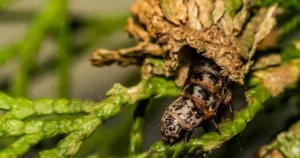Guarding Your Trees: The Stealthy Threat of the Evergreen Bagworm
Did you know that your favorite trees are thinning and losing their beautiful pine needles? You may be dealing with the infamous evergreen white bug infestation. Despite its name, these deceptive creatures are moths in the larval stage. If left unchecked, they can cause serious damage to your tree and even cause death. But don’t worry. There are ways to save trees if you know what to do.

Evergreen White Bug: The Silent Tree Killer
In the world of pests that threaten the health and beauty of trees, few are as well known as the evergreen bug. These small, inconspicuous creatures belong to the family Psychidae and are named for their special protective shells, sometimes called pouches or pouches. These bags, made from plant waste parts such as leaves, twigs and bark, hang from tree branches and hide acorn larvae.
The concept of the evergreen worm
The evergreen moth, scientifically known as Thyridopteryx ephemeraeformis, is a type of moth that damages evergreen and deciduous trees. Equipped with portable shelters and camouflage devices, they look like small bags hanging from tree branches. This deceptive creature is not a caterpillar, but a butterfly in the caterpillar stage.
Life cycle of evergreen worms
To effectively control infestations of evergreen whiteflies, understanding their life cycle is essential. The adult female lays eggs in a pouch and then hangs them on a tree. In late spring or early summer, these eggs hatch into tiny larvae that hatch in search of a suitable host tree. They start making bags using silk produced by special glands in their body.
As the larvae shed their skin and grow, they periodically emerge to fill the sacs with additional plant debris. This bag will look amazing over time. Whitefly larvae usually reach their final instar in late summer or early fall. After about six weeks, they are ready to kiss.

In the protective shell, the larvae undergo the transformation from the larval stage to the adult stage. Pupae grow in invisible worm nests. After about two weeks, the adult moths emerge through a round hole in the box. Wingless females stay close to the natal tree, while males, which are darker, smaller and have more distinct wings, fly in search of females.
The destructive nature of the evergreen beetle
Evergreen worms may seem harmless at first, but if left untreated, they can cause serious damage to your trees. These voracious eaters eat leaves and hide in bags, making them difficult to detect until the infestation becomes severe. Their feeding activity causes the leaves to drop, making it difficult for the tree to photosynthesize and produce the nutrients it needs to survive and grow. In addition, feeding weakens trees and makes them more susceptible to other diseases, pests and environmental stressors. If left untreated, evergreen whiteflies can cause damage to trees and even kill the tree.
Control of evergreen worm infestations
Prompt and effective management is essential to minimize damage from evergreen caterpillar infestation. Here are some strategies and tactics to consider:
Healing tree
It is always better to prevent evergreen leafworm than to treat it. Following these methods can help reduce the chances of infection and improve the overall health of your tree.

Check your trees regularly for signs of worms, such as bags hanging from the branches.
Cut and remove the bags before the larvae form and spread. Increase biodiversity in your landscape by planting a variety of tree species. This will help prevent whiteflies from infesting your tree. to fall into
Evergreen borers may be small and barely noticeable, but they have the ability to silently kill trees. By understanding your tree’s life cycle, understanding its destructive power, and implementing good management practices, you can protect your trees from these insidious invaders.
Regular inspections, preventative measures and maintenance of healthy trees can go a long way in keeping pests at bay and maintaining the beauty and vitality of your landscape. Don’t let the silent threat of evergreen white bugs ruin the health and beauty of your trees. Take action today to protect your favorite trees!